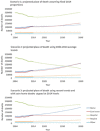What is the impact of population ageing on the future provision of end-of-life care? Population-based projections of place of death
- PMID: 29017018
- PMCID: PMC5788077
- DOI: 10.1177/0269216317734435
What is the impact of population ageing on the future provision of end-of-life care? Population-based projections of place of death
Abstract
Background: Population ageing represents a global challenge for future end-of-life care. Given new trends in place of death, it is vital to examine where the rising number of deaths will occur in future years and implications for health and social care.
Aim: To project where people will die from 2015 to 2040 across all care settings in England and Wales.
Design: Population-based trend analysis and projections using simple linear modelling. Age- and gender-specific proportions of deaths in hospital, care home, home, hospice and 'other' were applied to numbers of expected future deaths. Setting/population: All deaths (2004-2014) from death registration data and predicted deaths (2015-2040) from official population forecasts in England and Wales.
Results: Annual deaths are projected to increase from 501,424 in 2014 (38.8% aged 85 years and over) to 635,814 in 2040 (53.6% aged 85 years and over). Between 2004 and 2014, proportions of home and care home deaths increased (18.3%-22.9% and 16.7%- 21.2%) while hospital deaths declined (57.9%-48.1%). If current trends continue, numbers of deaths in care homes and homes will increase by 108.1% and 88.6%, with care home the most common place of death by 2040. If care home capacity does not expand and additional deaths occur in hospital, hospital deaths will start rising by 2023.
Conclusion: To sustain current trends, end-of-life care provision in care homes and the community needs to double by 2040. An infrastructure across care settings that supports rising annual deaths is urgently needed; otherwise, hospital deaths will increase.
Keywords: Aged; forecasting; health services need and demand; mortality; palliative care.
Conflict of interest statement
Figures
References
-
- World Health Organisation. World Health Organisation fact sheet: projections of mortality and causes of death, 2015 and 2030, http://www.who.int/healthinfo/global_burden_disease/projections/en/ (2014, accessed 19 December 2016).
-
- World Health Organisation. World Health Organisation fact sheet: the top 10 causes of death, http://www.who.int/mediacentre/factsheets/fs310/en/index2.html (2012, accessed 19 December 2016).
-
- Grande GE, Ewing G. Informal carer bereavement outcome: relation to quality of end of life support and achievement of preferred place of death. Palliat Med 2009; 23: 248–256. - PubMed
Publication types
MeSH terms
LinkOut - more resources
Full Text Sources
Other Literature Sources
Medical



